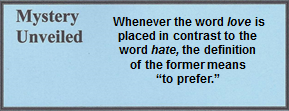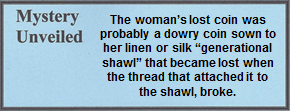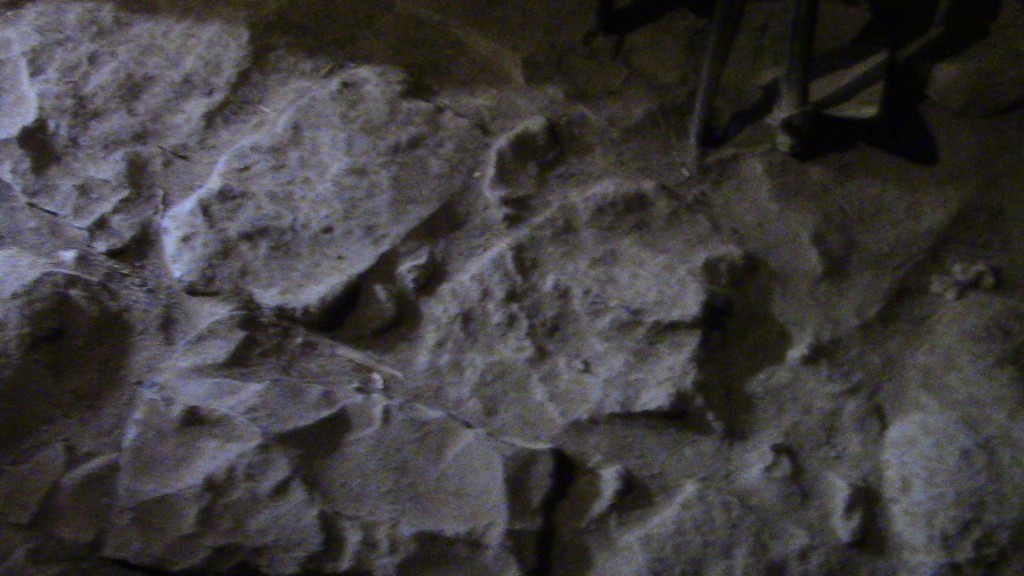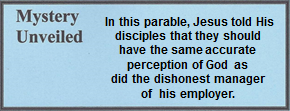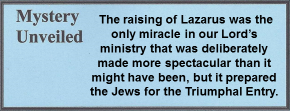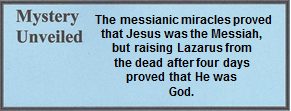12.03.08 Lk. 16:19-31
PARABLE OF THE RICH MAN AND LAZARUS
19 “There was a rich man who would dress in purple and fine linen, feasting lavishly every day. 20 But a poor man named Lazarus, covered with sores, was left at his gate.
21 He longed to be filled with what fell from the rich man’s table, but instead the dogs would come and lick his sores. 22 One day the poor man died and was carried away by the angels to Abraham’s side. The rich man also died and was buried. 23 And being in torment in Hades, he looked up and saw Abraham a long way off, with Lazarus at his side. 24 ‘Father Abraham!’ he called out, ‘Have mercy on me and send Lazarus to dip the tip of his finger in water and cool my tongue, because I am in agony in this flame!’
25 “ ‘Son,’ Abraham said, ‘remember that during your life you received your good things, just as Lazarus received bad things, but now he is comforted here, while you are in agony. 26 Besides all this, a great chasm has been fixed between us and you, so that those who want to pass over from here to you cannot; neither can those from there cross over to us.’
27 “ ‘Father,’ he said, ‘then I beg you to send him to my father’s house — 28 because I have five brothers — to warn them, so they won’t also come to this place of torment.’
29 “But Abraham said, ‘They have Moses and the prophets; they should listen to them.’
30 “ ‘No, Father Abraham,’ he said. ‘But if someone from the dead goes to them, they will repent.’
31 “But he told him, ‘If they don’t listen to Moses and the prophets, they will not be persuaded if someone rises from the dead.’”
This parable was created specifically for the leading Pharisees and Sadducees. As previously stated, they believed in a “first century-style prosperity theology,” meaning that God gave wealth only to those whom He loved. Therefore, in their opinion, God loved them and hated the poor. In fact, they thought it was wrong to give to the poor, because the gift would go to one whom God had cursed. At the root of this thinking was an incorrect interpretation of Deuteronomy 28. From this passage, they determined those in poverty had done some evil deed, or their parents did and, hence, they were suffering the consequences. At the conclusion of His speech, Jesus said, “If they don’t listen to Moses and the prophets, they will not be persuaded if someone rises from the dead.” This is precisely what the Scribes, Levites, leading Pharisees and Sadducees did after Jesus arose from the grave.
Cast of Characters
Rich man = Annas and Caiaphas
Purple and fine linen = Garments of the high priest
Feasting lavishly = Indolent self-indulgence
Lazarus = The Jewish people
Five brothers = Five sons of Annas
In this parable, the rich man who was wealthy because of divine favor he had had ample opportunity to fulfill the second most important commandment: to help his neighbor. Then he died and his soul was impoverished in Hades,[1] while Lazarus was wealthy in Abraham’s bosom – a common phrase in Jewish writings. While the rich man was a son of Abraham, his sonship did not keep him out of the lake of fire, as the Pharisees believed it would.
He failed to share his good fortune with a poor man named Lazarus. This type of giving was called “almsgiving,” whereas the “tithe” was ten percent and given to the local synagogue.[2] There is no mention of tithing, but the story is focused on giving to the poor or the failure to do so. Lazarus barely survived from the scraps given to him by the rich man. Even the dog had more compassion on Lazarus, as shown by the licking of his wounds. Eventually, both men died. Lazarus went to be with Father Abraham, while the rich man went to Hades, the place of the dead who were separated from God and waiting final judgment. According to the story, when the two men could speak, the rich man called upon Lazarus for some relief as he was suffering from the fire. However, there was nothing Lazarus could do. The wealthy man was very shrewd for his immediate gratification, whereas he should have been shrewd about his eternal destiny.
There has always been a debate among scholars as to whether this story was an actual event or if it was told to illustrate biblical truth. The difficulty all too often lies in the debate, rather than on the focus of the message. However, the Master Teacher Jesus at times took real life situations and stories and used them within His parables. In this case, Jesus could have created a story wherein rich man had three brothers, or six brothers, but instead, He mentioned five. Why? Could the story have been intended to reflect upon someone with five sons or brothers?
Many scholars believe that the story of Lazarus and the rich man is more than a moral invention; it was directed toward Annas, the retired high priest who had five sons. The rich man and his five brothers did not listen to Moses or to the prophets, nor did they care about an eternity after death. Annas, his son-in-law Caiaphas, and the five sons of Annas were Sadducees and from time to time, held the office of high priest. While Sadducees claimed to believe in the books of Moses, their lifestyle did not in any way reflect that belief. If they truly believed Moses they would have been obedient to the Mosaic Laws. Since actions come out of what the heart believes, obviously they did not believe him.
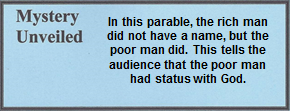
In this manner of teaching, Jesus did not make a direct assault on Annas, but everyone knew of whom Jesus was speaking. This style of indirect confrontation was common in ancient Judaism. For more information on this style of communication, see “Education” in 02.03.04.
“There was a rich man.” Some theologians believe this illustration was an actual event and recorded in Scripture as a narrative and not as a parable. Their primary reasons for this interpretation are,
- The introductory phrase, “there was a rich man,” obviously indicating the existence of an actual person, and
- The name of a second person: Lazarus.
- Furthermore, since the account refers to a resurrection it has also been suggested that there is a correlation to the story of Lazarus, whom Jesus raised from the dead (Jn. 11). But this is purely coincidental because the name Lazarus, like Jesus, was a common name.
However, this writer disagrees with that assessment. At this point, a quick review of the essential elements of a parable is necessary. Parables have a single point or theme and are created stories that are true to life. Therefore, to have a phrase, “There was a rich man,” does not disqualify it from being a parable. Furthermore, in Jewish literature, parables are known to have names of individuals and places, although no others are found like it in the New Testament.
Rich men were often assumed to have attained their wealth either by the blessings of God or by dishonest means. Since most people assumed the latter, the proverbial “rich man” became the subject of stories and parables in which he was condemned and the poor peasant would live happily ever after. The story gave hope to those in a life of poverty.
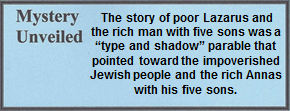
The rich man’s wealth was described in the clothing he wore. The phrase, “who would dress in purple and fine linen,” is indicative of extreme wealth. For centuries purple dye was made from the secretions of four seashell creatures[3] that lived along the eastern Mediterranean coast.[4] The dye masters of Tyre created variations of purple or scarlet that could be obtained by mixing the secretions. Since a large number of creatures[5] was needed for the production of a small quantity of dye, the process was labor intensive and very expensive.[6]
The term fine linen was a fabric known in Greek as bussos or byssus.[7] It was second in value to silk, which was worth its weight in gold.[8] It was made from Egyptian cotton and used for the finest garments, including underwear.[9] The Greek writer Herodotus said it was used for wrapping Egyptian mummies.[10] While byssus was made in Samaria and Judea, the finest quality, such as the white garments the high priest wore on the Day of Atonement, is believed to have been imported from India and Egypt.[11] The man in this parable was not simply wealthy, but in modern terms, he was “filthy rich,” and dressed arrogantly to show it off.
“Dogs would come and lick his sores.” This statement describes the desperate level of poverty that Lazarus endured. It would have been bad enough if it was the rich man’s pet dog that came to Lazarus, like the dog referred to by the woman in Matthew 15:26. In Greek, a dog is called a kunaria, an affectionate household pet.[12] But here Jesus described ordinary street dogs, the kind that roamed from rubbish heap to rubbish heap – the kind that was descriptive of Gentiles. There is a huge difference between the two.[13] In this case, even those stray and shaggy dogs seemed to have pity on Lazarus as they licked his sores out of affection.[14]
“Abraham’s side.” This is a Hebrew euphemism meaning “to be with God.”[15] The Jews believed that the Patriarchs, who had passed on from this earth, were with God in a temporary place until the final judgment at the end of the age.[16] This place, consisting of two divisions is Hades (not Hell).
In this story, Jesus gives us eternal insight into the knowledge all will have during eternity. The wealthy individual in hell will be able to remember the opportunities he had in life to do what was right, but he chose not to change. He will be able to remember his lucrative lifestyle and the lack of mercy for the poor beggar. Now he is in eternal torment without any hope whatsoever.
There are numerous stories from antiquity that feature a certain rich man and a poor man and how their fortunes changed in the next world. Similar stories abound of a king and his subject. This was probably due to the fact a vast majority of the people were poor peasants, who could barely eke out a living, and the rich and powerful lived a life of ease as merchants, priests, and government officials. At least eight variations of the biblical narrative have been found, not only in the Jewish culture, but also neighboring cultures as well. Many Middle Eastern cultures had similar laws, legends, and customs. A study of the Egyptian, Babylonian, and Jewish cultures reveals such similarities.[17] All societies have rich man / poor man stories, just as they have had prince and pauper and husband and wife stories. In the Midras Coheleth is a parable of a rich man and a beggar named Diglus Patragus or Petargus. Another account is found in the Hieros Peah.[18] These stories have a land called Elysium for the blessed and a land called Tartarus for the damned with a river Cocytus or Acheron between the two; or there may be a great gulf or wall between them.[19] The following narrative is a short section of a longer story found on the backside of two Greek business manuscripts, written on papyrus, and now in the British Museum:
At a still more tender young age the boy took his father on a tour of Amnte. This he had to do because of a remark he made one day about two funerals:
A rich man (died and) was borne out to the mountain, shrouded in fine linen, loudly lamented, abundantly honored; then a poor man (died) wrapped in a mean straw mat, unaccompanied, unmourned, was taken out to the necropolis of Memphis. The father exclaimed he would rather have the lot of the rich man than that of the pauper.
But (the) little (boy) Si-Osiris impertinently contradicted his father’s wish with the opposite one: And may it be done to you in Amnte as it is done in Amnte to this pauper, and not as it is done to this rich man in Amnte.
He who has been good on earth will be blessed in the kingdom of the dead, and he who has been evil on earth will suffer in the kingdom of the dead.
Midras Cohelet [20]
In the Jerusalem Talmud is a story that has the typical rich man / poor man motif. As in the parable of Jesus, this story features the eternity of the wealthy man who obeyed the law, but had no good deeds at the end of his life. But another man, who was a kind tax-collector and was admired by his neighbors, died and went to Paradise. This writer uncovered seven Jewish versions of this story during the research for this eBook, which indicates that it was a popular first century story.[21] The following narrative was recorded twice in the Jerusalem Talmud.
Two godly men lived in Ashkelon.[22] They ate together, drank together and studied law together. One of them died and kindness was not shown to him (because nobody attended his funeral). The son of Mayan, a tax collector, (also) died, and the whole city stopped work to show him kindness. The (surviving) pious man began to complain; he said: “Alas that no evil comes upon the haters of Israel!” In a dream he saw a vision; and one said to him: “Do not despise the children of the Lord.” The (pious) one had committed one sin and departed (this life) in it (i.e. his mean funeral canceled it); and the other wealthy publican had performed one good deed and departed (this life) in it (i.e. his splendid funeral canceled it).
After some days the godly man saw the godly one his (former) companion walking in gardens and parks besides springs of water (in Paradise). And he saw the son of Mayan, the publican, stretching out his tongue on the edge of a river; he was seeking to reach the water and he could not.
Jerusalem Talmud, Hagigah 2.77d[23]
What is to be learned from these examples is that the Master Teacher spoke the language of the people. He transformed stories they knew to present His message of love, salvation, and the Kingdom of God. But in doing so, at times He also gave interesting allusions that would make them wonder what He meant – such as a possible allusion to Annas and his five sons. Such “brain teasers” helped people remember what He said. And the most important lesson is that there is a real heaven and a real hell with a great separation between the two – and Jesus is the only way to obtain eternal life.
“Lazarus at his side.” Some translations read that Lazarus was reclining in Abraham’s bosom. This is a significant point because means that he was enjoying a meal with someone – probably Abraham.[24] Furthermore, reclining at mealtime was a sign of wealth, comfort, and leisure – all the things that the rich man enjoyed for a short season called “life.” Just as Jesus reclined with His disciples at Passover, so likewise did Lazarus enjoy the company of Abraham.
A Lesson in First Century Hermeneutics:
12.03.08.X A Parable That Reflects History
Parables can be newly created or reflect a person or event in history. The advantage of a reflective parable is that the hearers would remember it better. There are a number of examples of this, including the following passage.
The Jews believed that, unless there was some horrific sin in one’s life, eternity in Paradise was an assured certainty because they were the chosen people of God. The fact that the Master Teacher took a common story from daily life which people were already familiar with, and used it to teach His message, appears to be absent from modern hermeneutics. Nonetheless, the point of this story is the equalizing justice of God.
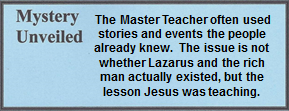
Jesus illustrated the danger the Pharisees were in because they despised and rejected those who were ignorant and poor, rather than helping them. To the Sadducees the parable meant that the temple aristocrats were totally consumed in their own pleasures and were indifferent to the needs of others, even to the leading Pharisees.[25]
In the story there is “a poor man named Lazarus,” or, as some translations read, “a beggar named Lazarus.” His name in Hebrew is Eleazar, meaning he whom God helps, which is a key point to the parable.[26] This is certainly an interesting name, as he received no help from his wealthy neighbor. In fact, it appeared that God did not help him either, but he received abundant help from God in the next world. The misery and wretchedness of Lazarus is illustrated in the rabbinical saying: “There are three men whose life is no life (it is simply miserable):
- He who depends on the table of another (for food);
- He who is ruled by his wife; and
- He whose body is burdened with sufferings.”[27]
Lazarus was the first of these three miserable men. Furthermore, Jesus placed a double emphasis upon Lazarus and the rich man. Not only was the poor man named he whom God helps, but the fact that it was Jesus who gave him a name adds significant status. In the same manner, the man who was rich and had status on earth now has neither name nor riches in hell.
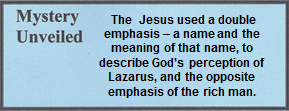
The rich man recognized Lazarus as being in Paradise. Between the two men was a great divide, an impassable gulf between Hades and Paradise. Interestingly, the rich man desired that someone return to his home community to warn others of the pending reality of the eternal place of punishment. Ironically, Jesus was that person.
“Covered with sores.” Literally, a medical term meaning to be ulcerated.[28] Obviously he had oozing open wounds that must have been painful. This description intensifies the lack of care and respect on the part of the rich man. In fact, not only did the rich man not care about the health of Lazarus, he didn’t even toss any food to him either. Most people, even the most hard-hearted, would have shown some compassion and pity for this impoverished beggar, but he didn’t.
“Was left at his gate.” The fact that Lazarus was left at the rich man’s gate (described with a passive in the Greek text)[29] indicates that he was too ill to get there by himself and family and friends had to carry him to that location. This description adds to the pitiful sight and the fact that the rich man obviously knew he was there.
12.03.08.Q1 How could secular cultural stories become part of the inspired text (Lk. 16:19-31)?
It could be said that the answer is a “God thing.” As previously stated, Jesus, as the Master Teacher, often took a well-known story and changed it to suit His teaching. This helped the listeners remember what He taught. The Apostle Paul did a similar feat. In Acts 17:28 Paul made a quotation from two Greek poets whose writings were well known to the people to whom he preached. He quoted Cleanthes (Hymn to Zeus) and Aratus of Soli (Phaenomena, a poem on astronomy) in his Areopagus address. Of the two ancient Greek writers, scholars are divided as to who was the original author of the words that were copied twice. However, it is also possible that both of them quoted the Cretan philosopher-poet Epimenides, who lived about 7th or 6th century B.C.[30]
This is an interesting parable since it has always been sinful to speak to the dead (i.e. King Saul with the witch at Endor), but the Jews believed that the dead could speak to each other. The Talmud recorded several such instances[31] and this parable, which is somewhat mystical was, in fact, on par with prevailing beliefs of the Jewish culture.[32] The problem most evangelicals have with this biblical account and obvious multiple versions in Jewish and pagan writings, is that we have assumed the biblical narrative was either an actual event or a parable or story completely original by Jesus. It should not be difficult for modern students to accept the fact that Jesus used stories that were in common use so that His listeners could easily remember His lessons. This parable simply underscores the great lengths God is willing to go to bring an understanding of the Kingdom of God to a lost generation.[33]
The issue is not whether the account of the rich man and Lazarus was an actual historical event or if it was a story with a life-like setting. The Apostle Paul even said that believers should not argue about words (2 Tim. 2:14), especially since it is easy to get caught up in this discussion and miss the main issues. Those issues reflect the status of the lost as…
- Eternally separated from God,
- Their state of lostness and hopelessness,
- The suffering of continuous torment,
- The condition is unchangeable and eternal, and
- The lost will forever remember missed all opportunities that were available to find salvation.
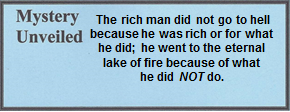
Finally, there are a few observations to be considered.
- It was the common belief that those in heaven could see and mock those in hell. But by silence, Jesus refutes that concept. Lazarus did not torment the rich man.
- The rich man never addressed Lazarus, but called upon Father Abraham to help him. Even in his place of torment, he was too proud to call upon his former impoverished neighbor.
- The rich man was not a Gentile, but a Jew who had all the imagery of a successful life. There is no mention as to whether he was observant of all the Jewish laws, so it can be assumed that his sin was that he was indifferent to the needs of others.
- The situation of the rich man is the same as what occurred in the church of Laodicea. It was a church that was extremely wealthy and in need of nothing, but Jesus called those believers poor, wretched, blind and naked and said they needed to repent (Rev. 3:14-19).
- In this parable, the food from the rich man’s table was thrown away, but not toward poor Lazarus. Rather, the food was thrown to the dogs. The same theme appears in the narrative of the Syro-Phoenician woman who pleads for the bread thrown to dogs. It was common practice for unwanted food to be thrown to dogs that guarded the home.[34]
- While alive on earth, Lazarus was in pain but was ignored by the rich man. Now the situation was reversed: the rich man was in pain and desperately wanted help – the kind of relief he refused to give to Lazarus. Once Lazarus was a beggar but is now rich while the rich man becomes the beggar, and remains condemned as such for all eternity.
The parable of Lazarus and the rich man points to the principle of Luke 12:48 that says that to whom much is given, much will be required. Likewise with the rich young ruler who obeyed all the laws of Scripture, but his wealth owned him.
[1]. As will be explained in further detail, Hades had two sides: 1) Abraham’s Bosom where Old Testament saints went prior to Jesus taking them to heaven, and 2) the other side where sinners went prior to their descent into hell. This is the only place in the Bible where the phrase “Abraham’s Bosom” is found.
[2]. Josephus spoke of corrupt priests who stole the tithes from other priests in Antiquities, 20.9.2, found herein in, “A den of robbers,” 13.02.02. He also mentioned it in Antiquities 20.8.8 as found herein in “The chief priests” in 15.02.09. See additional rules on tithing in the Mishnah, Ma’aserot 1.1 and Moed Shabbath 4.7. The point is that tithing was a well-established practice.
[3]. Technically speaking, the four types of molluscs were known as helix ianthina, murex brandaris, murex trunculus, and purpura lapillus.
[4]. Oldest known cloth murex-dyed known today dates to the fifth to fourth century BC. However, the older Papyrus Anastasy (now in the Victoria Museum in Upsala, Sweden) was written about 1400 B.C. in Egypt, and includes about 70 formulae for dying wool, most of which deal with the color purple. It has been estimated that nearly 10,000 snails needed to be crushed to produce enough liquid to dye a single garment. For more information, see Philippa Scott “Millennia of Murex.” Saudi Aramco World. July-August, 2006. 30-37.
[5]. It has been estimated that 8,000 of these molluscs were needed to produce 1 gram of dye. See Irvin, “Purple.” 1057.
[6]. Irvin, “Purple.” 1057. According to Josephus, large quantities of purple (or scarlet) fabric were required for the temple curtains which were replaced every few years (Wars 6.8.3 (390). Some scholars believe that the purple (or scarlet) robe placed on Jesus (Mt. 27:28) was a soldier’s cloak.
[7]. Bailey, Jesus through Middle Eastern Eyes. 382.
[8]. Vincent, Word Studies in the New Testament. 1:397.
[9]. Bailey, Jesus through Middle Eastern Eyes. 382.
[10]. The History of Herodotus 2.86. Translated by George Rawlinson http://classics.mit.edu/Herodotus/history.3.iii.html Retrieved November 30, 2013.
[11]. Mishnah, Yoma 3.6-7.
[12]. Vincent, Word Studies in the New Testament. 1:89; Lang, Know the Words of Jesus. 71; Bock, Jesus According to Scripture. 221-22.
[13]. Barclay, “Matthew.” 2:122-23.
[14]. Bailey, Jesus through Middle Eastern Eyes. 384-85.
[15]. Pentecost, The Words and Works of Jesus Christ. 339-40.
[16]. Saunders, “Abraham’s Bosom.” 1:21-22.
[17]. An examples of similar stories of a dialog between heaven and the underworld in Jewish writings can be found in 4 Ezra [=2 Esdras] 7:85, 93; 2 Baruch 51:5-6. A later tradition, written in the Christian era, is found in the Babylonian Talmud Basah 32b.
[18]. Lightfoot, A Commentary on the New Testament from the Talmud and Hebraica. 3:166-67.
[19]. Lightfoot, A Commentary on the New Testament from the Talmud and Hebraica. 3:175.
[20]. Beasley-Murray, Preaching the Gospel. 214-15 quoting K. Grobel, “Whose Name was Nerves.” 376-78.
[21]. Gressmann, Der Messias. 59.
[22]. Ashkelon is an ancient Philistine city along the coast that was eventually inhabited by the Israelites.
[23]. This comment is also found in the Jerusalem Talmud. Sanhedrin 6.23c; Beasley-Murray, Preaching the Gospel. 215; Manson, 297; Major, Manson, and Wright, The Mission and Message of Jesus. 588-89. Parenthesis by Jerusalem Talmud editors.
[24]. Bailey, Jesus through Middle Eastern Eyes. 374.
[25]. Major, Manson, and Wright, The Mission and Message of Jesus. 590.
[26]. Barclay, “John.” 2:80-81; Bailey, Jesus through Middle Eastern Eyes. 382.
[27]. Jerusalem Talmud, Besa 32b; Major, Manson, and Wright, The Mission and Message of Jesus. 591.
[28]. Vincent, Word Studies in the New Testament. 1:398.
[29]. Bailey, Jesus through Middle Eastern Eyes. 219.
[30]. Blaiklock, “Poets, Pagan, Quotations from.” 13:1646-47.
[31]. Babylonian Talmud, Berakhot 18b.
[32]. Edersheim, The Life and Times of Jesus the Messiah. 669.
[33]. Blaiklock, “Poets, Pagan, Quotations from.” 13:1646-47.
[34]. Bailey, Jesus through Middle Eastern Eyes. 384.
